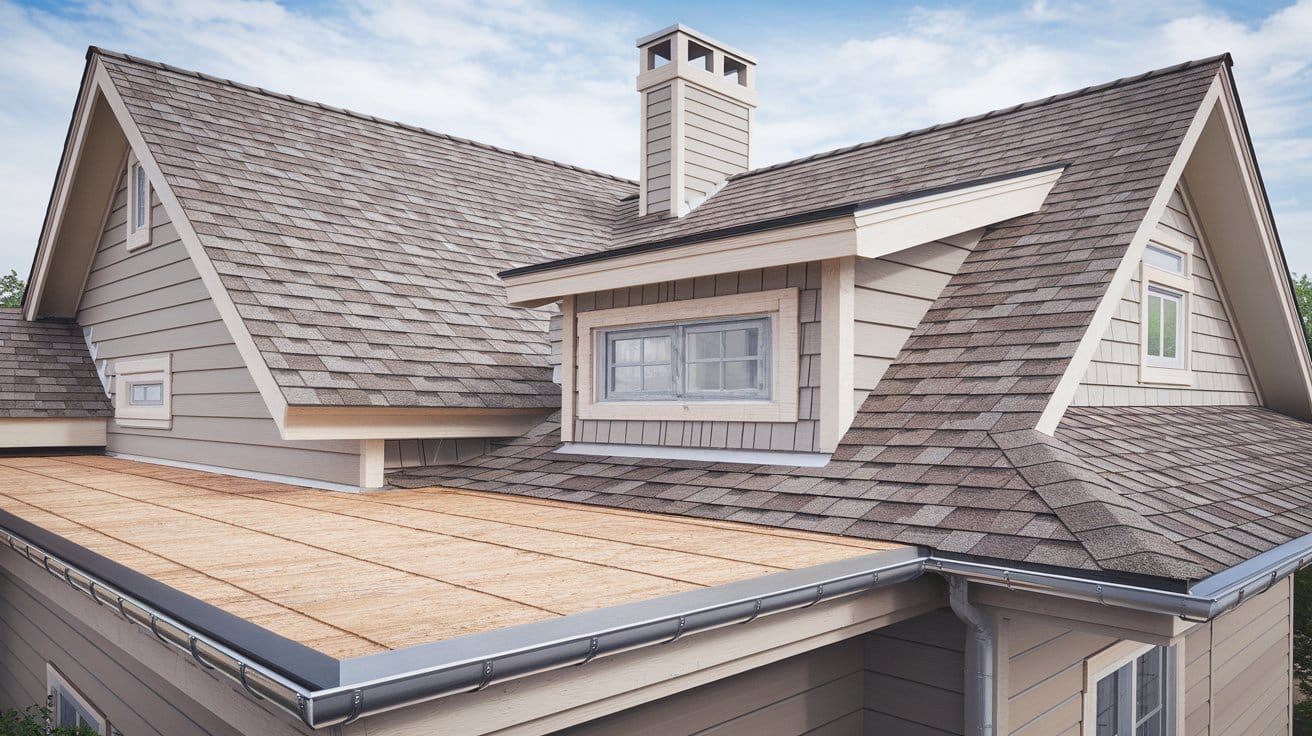Have you ever looked at your roof and wondered what all those different parts are called?
Most homeowners can spot obvious issues like missing shingles, but when contractors start talking about fascia, soffits, and ridge vents, things get confusing fast.
Here’s the thing: knowing basic roof terminology can save you hundreds of dollars. When you understand what roofers are discussing, you can make better decisions about repairs.
You won’t get talked into replacing parts that are still in good condition. This blog breaks down the essential roof parts every homeowner should know.
You’ll learn what each component does and why it matters for your home’s protection. By the end, you’ll speak roof language like a pro and feel confident during any roofing conversation.
Basic Roof Structure Overview
Think of your roof like a layered system that works together to protect your home. Each part has a specific function, from the wooden frame that supports everything to the outer materials that prevent water from entering.
The structural foundation begins with rafters or trusses, which are the wooden beams that form the shape of your roof. On top of this frame sits the decking, which gives your roof a solid surface.
Next comes the protective layers. Underlayment goes directly on the decking to block moisture. Then your shingles, tiles, or metal roofing provide the final weather barrier.
The edge and drainage systems include gutters, eaves, and fascia boards. These parts channel water away from your home, giving your roof a finished look.
Finally, specialty features like vents, flashing, and dormers handle specific needs. Vents let air flow through your attic. Flashing seals joints where water might sneak in. Dormers add space and light to upper floors.
Knowing this basic structure helps you see how each roof part fits into the bigger system.
Why Knowing Roof Terminology is Important?
Understanding roof terminology gives you real power as a homeowner. When you know what contractors are talking about, you can make smarter choices about your home’s biggest investment.
Key Benefits of Knowing Roof Terms
- Save money on repairs: You’ll spot when contractors suggest unnecessary work or overcharge for simple fixes.
- Communicate clearly with professionals: No more nodding along when roofers use technical terms you don’t understand.
- Make informed decisions: Compare quotes accurately when you know exactly what each item means.
- Prevent getting scammed: Knowledge protects you from dishonest contractors who prey on confused homeowners.
- Handle insurance claims better: Insurance adjusters use specific roof terminology in their reports and settlements.
- Plan maintenance properly: Know which parts need regular attention and which warning signs to watch for.
When you speak the same language as roofing professionals, you’re treated as an informed customer rather than an easy target. This knowledge pays for itself the first time you need roof work done.
Common Roofing Terminology You Should Know
These are the roof parts you’ll hear contractors mention most often. Knowing these terms helps you understand what needs repair and why it matters for your home’s protection.
Structural Elements
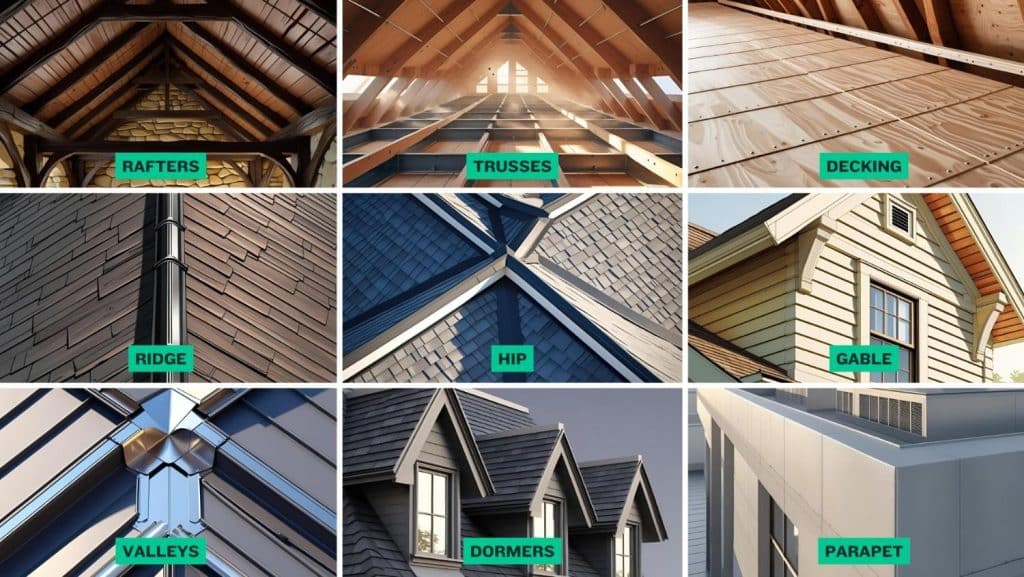
Your roof’s structural elements form the backbone that holds everything together. These key components work together to support the weight of materials, weather, and time, while creating your home’s distinctive roofline.
1. Rafters
Traditional wooden beams that run from your roof’s peak down to the walls. They create the roof’s slope and support all the weight above. Older homes typically use rafters instead of modern truss systems.
2. Trusses
It is Pre-built triangular frames that replace individual rafters. Made in factories for consistency and strength. Trusses span wider distances and cost less than traditional rafter construction. Most new homes use truss systems today.
3. Decking/Sheathing
Plywood or OSB boards nailed directly to rafters or trusses. This creates a solid surface for everything else. Decking must be strong enough to hold shingles, snow, and workers during installation or repairs.
4. Ridge
The highest point where the two roof slopes meet at the top. Ridge vents often run along this peak to let hot air escape from attics. Proper ridge construction prevents leaks at this critical junction.
5. Hip
External angle where two roof slopes meet. Hip roofs have slopes on all four sides instead of vertical gable ends. This design handles wind better but requires more complex construction.
6. Gable
Triangular wall section under the peak where two roof slopes meet. Gable ends are typically covered with siding that matches the exterior of your home. Some gables include decorative vents for attic ventilation.
7. Valleys
An area where two roof slopes meet and form an inward angle. Water flows down valleys toward gutters. These spots need special flashing and careful installation to prevent leaks and ice dams.
8. Dormers
Small roofed structures that project from sloped roofs. They add window space and headroom to upper floors. Dormers require careful flashing work where they connect to the main roof structure.
9. Parapet
A low wall that extends above the roofline, common on flat or low-slope roofs. Parapets provide fall protection and can hide mechanical equipment. They require special drainage and waterproofing to prevent problems.
Protective Layers and Drainage
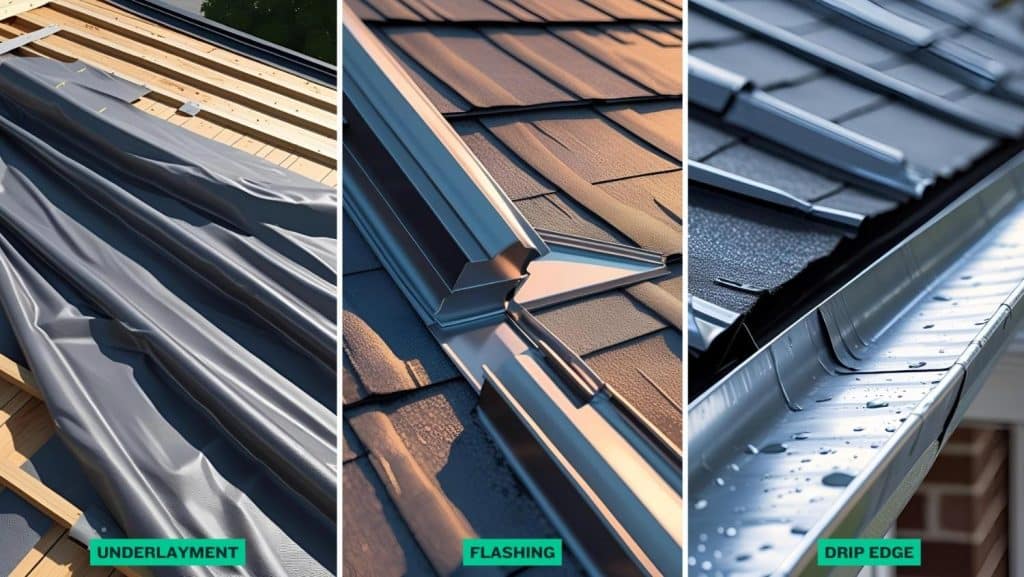
Water protection is your roof’s most important job, and these components create multiple barriers against leaks. From backup waterproofing to directing water flow, each element plays a vital role in keeping your home dry.
1. Underlayment
It is the waterproof barrier installed over the decking before shingles go on. Acts as backup protection if water gets past your main roofing material. Common types include felt paper, synthetic materials, and peel-and-stick membranes.
2. Flashing
Metal strips that seal joints between different roof materials or features. Prevents water from entering at chimneys, vents, skylights, and valleys. Proper flashing installation is critical for preventing leaks.
3. Drip Edge
It refers to the metal strips installed along roof edges to direct water into gutters. Prevents water from running back under shingles or rotting fascia boards. Building codes in many areas require drip edge installation.
Finishing and Ventilation Components
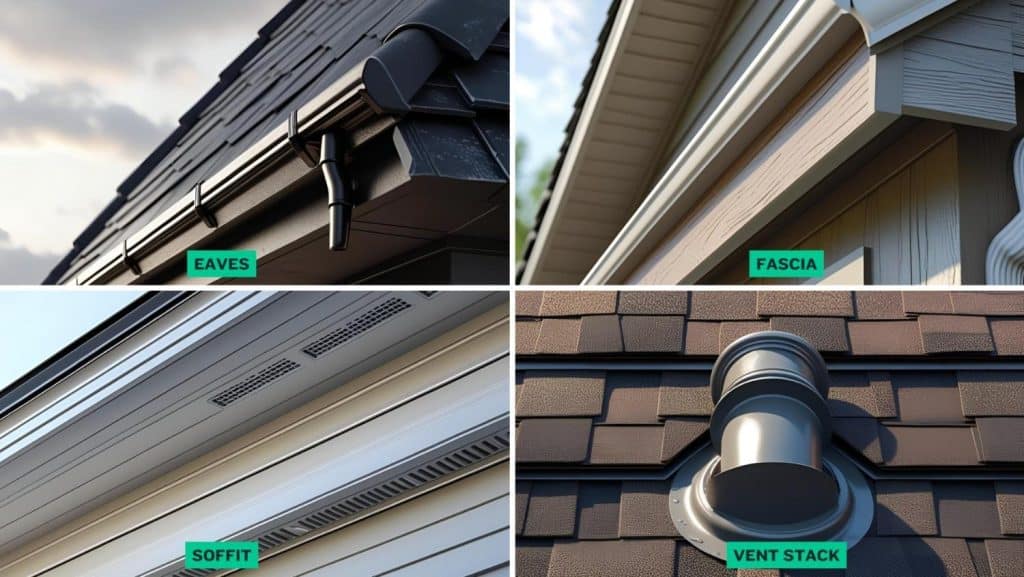
These elements give your roof its polished appearance while ensuring proper air circulation. They combine function with form to create clean lines and healthy attic conditions.
1. Eaves
The bottom edge of your roof that hangs over exterior walls. Eaves protect walls from rain and provide shade. They also create space for soffit vents that help air flow through your attic.
2. Fascia
It is a vertical board attached to rafter ends along the eaves. Fascia gives your roofline a clean, finished appearance. Gutters typically attach to fascia boards, so they must be strong and properly maintained.
3. Soffit
Horizontal panels under the eaves between the fascia and the exterior walls. Soffits often have vents that let fresh air enter your attic. They also hide rafter ends and wiring for a cleaner look.
4. Vent Stack
A vertical pipe that extends through your roof to vent plumbing gases. These pipes need special flashing and boots to prevent leaks. Vent stacks are common leak points if not properly sealed.
Measurements and Slopes
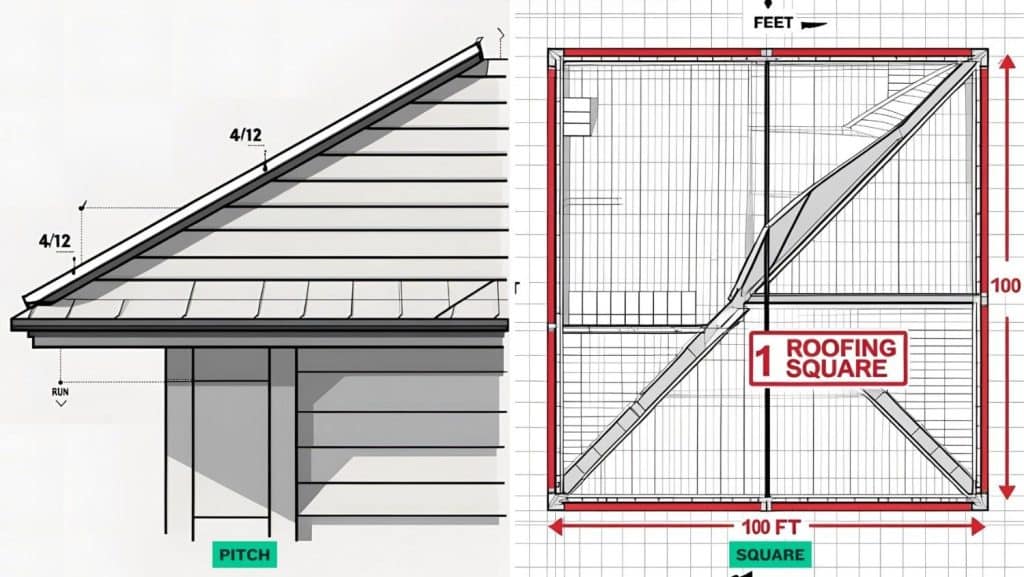
Understanding roof measurements and angles enables you to communicate effectively with contractors and plan projects efficiently. These terms describe how your roof’s size and steepness affect everything from water drainage to material costs.
1. Pitch
The steepness of your roof is expressed as a ratio. A 4/12 pitch rises 4 inches for every 12 inches horizontally. Steeper pitches shed water more quickly but are more expensive to build.
2. Square
Roofing measurement is equal to 100 square feet of roof area. Contractors use squares to estimate material needs and labor costs. A typical home might need 15-25 squares of shingles.
Conclusion
Now you know the essential roof parts that every homeowner should understand. From rafters that support your roof to flashing that keeps water out, each component plays a vital role in protecting your home.
This knowledge empowers you to take control during roofing conversations. You can ask smart questions, compare quotes fairly, and spot when contractors try to oversell unnecessary work.
Remember these terms when planning maintenance or repairs. A small leak in flashing costs much less to fix than waiting until water damages your decking or rafters.
What roof terms have you heard contractors use that confused you? Share your experiences in the comments below and help other homeowners learn from your situation.
Frequently Asked Questions
What Are the 4 Parts of A Roof?
The four main roof parts are the cover material (shingles or tiles), attic ventilation system, insulation layer, and drainage system, including gutters for proper water flow.
What Are the Things on My Roof Called?
Common roof features include courses (horizontal shingle rows), drip edge (metal strips at edges), and eaves (lower roof edges that overhang beyond house walls).
What Is the Overhang of A Roof Called?
The roof overhang is called an eave. This includes the entire overhanging section with the soffit underneath and fascia board at the vertical edge.

